Abstract
Complement is a humoral defense system that protects the host from microorganisms by inducing an inflammatory reaction at the site of invasion. However, complement activation is not limited to microbial protection, but is generally activated in any tissue damage irrespective of the stimulus that initiated the reaction. Thus, complement is a double-edged sword which, when activated improperly, may contribute to inflammation and tissue damage. Weisman et al. demonstrated in 1990 that specific complement inhibition markedly reduced tissue damage in experimental myocardial infarction (1), a number of animal and clinical studies have documented that activation of complement contributes to the ischemia/reperfusion injury in general, and to the pathophysiology of various autoimmune diseases, trauma, systemic inflammatory response syndrome, septicemia, and transplant rejection (for review, see refs. 2–5).
Similar content being viewed by others
References
Weisman, H. F., Bartow, T., Leppo, M. K., Marsh, H. C., Jr., Carson, G. R., Concino, M. F., et al. (1990) Soluble human complement receptor type 1: in vivo inhibitor of complement suppressing post-ischemic myocardial inflammation and necrosis. Science 249, 146–151.
Asghar, S. S. and Pasch, M. C. (2000) Therapeutic inhibition of the complement system. Front Biosci. 5, E63–E82.
Sahu, A. and Lambris, J. D. (2000) Complement inhibitors: a resurgent concept in anti-inflammatory therapeutics. Immunopharmacology 49, 133–148.
Makrides, S. C. (1998) Therapeutic inhibition of the complement system. Pharmacol. Rev. 50, 59–87.
Kirschfink, M. (1997) Controlling the complement system in inflammation. Immunopharmacology 38, 51–62.
Mollnes, T. E. and Harboe, M. (1993) Neoepitope expression during complement activation — a model for detecting antigenic changes in proteins and activation of cascades. Immunologist 1, 43–49.
Mollnes, T. E., Lea, T., Harboe, M., and Tschopp, J. (1985) Monoclonal antibodies recognizing a neoantigen of poly(C9) detect the human terminal complement complex in tissue and plasma. Scand. J. Immunol. 22, 183–195.
Link, C., Hawlisch, H., Vilsendorf, A. M. Z., Gyleruz, S., Nagel, E., and Köhl, J. (1999) Selection of phage-displayed anti-guinea pig C5 or C5a antibodies and their application in xenotransplantation. Mol. Immunol. 36, 1235–1247.
Author information
Authors and Affiliations
Editor information
Editors and Affiliations
Rights and permissions
Copyright information
© 2003 Humana Press Inc.
About this protocol
Cite this protocol
Mollnes, T.E. (2003). Measurement of Complement Activation. In: Winyard, P.G., Willoughby, D.A. (eds) Inflammation Protocols. Methods in Molecular Biology, vol 225. Humana Press. https://doi.org/10.1385/1-59259-374-7:69
Download citation
DOI: https://doi.org/10.1385/1-59259-374-7:69
Publisher Name: Humana Press
Print ISBN: 978-0-89603-970-4
Online ISBN: 978-1-59259-374-3
eBook Packages: Springer Protocols




